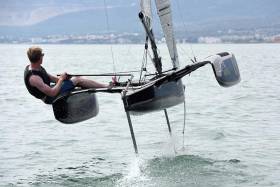Displaying items by tag: Flying Mantis
See The Award-Winning ‘Flying Mantis’ Foiling Trimaran At The RYA Dinghy Show 2019
The award-winning Flying Mantis foiling trimaran will be showing in its latest, all-red hull design at the RYA Dinghy Show 2019 at Alexandra Palace next weekend.
Voted best Dinghy of the Year against stiff competition in the recent British Yachting Awards, Flying Mantis says its design makes foiling attainable for sailors of all shapes, sizes and levels of ability.
The all-carbon dinghy can accommodate taller sailors, weighing up to 120kgs, while the two sleek, wave-piercing outriggers bring excellent stability.
The concept behind this high-performance, fast dinghy design is for performance foiling to be open to all and easy to do.
British designed and built, the boat is quick and simple to set up and dismantle, so you have more time afloat.
Being very light (approx 25kg central hull and 12.5kg outriggers) the boat will take off at lower speeds enabling more fun in lighter breezes.
Flying Mantis MD Simon Chrispin says: “The joy of foiling is incredible. It’s addictive.
“The Flying Mantis is for sailors who want the thrills and experience of foiling a performance dinghy, yet who want to be confident that they will master it, before investing hours of their time learning the skills, or taking involuntary swims!
“Not all of us are svelte athletes either. The Flying Mantis opens up foiling to a much wider range of sailors who want to get airborne and share the fun.”
A unique selling point of the Flying Mantis is that it is really two boats in one, so it’s flexible for all the family.
As well as comfortably carrying crews up to 120kg, it can be switched from the central T-foil mode to a non-foiling configuration.
This lightweight trimaran has a regular rudder and daggerboard, enabling sailing in a wide range of conditions, from light airs to very windy, and progression at your own speed to foiling.
It means you can get afloat when others may be putting the cover back on if there is too much or too little breeze for foiling.
British Sailing Team member Sam Whaley said after his boat test: “I really loved the boat. It has the elegance of a Rolls Royce with the speed of a Moth! Very impressed!”
The all-carbon hulls are customisable, too. The boat on display at this year’s RYA Dinghy Show is an all-red model and will be showing the new rudder stock, for low hassle launching and recovery, plus a new dagger board and lift-up rudder for displacement sailing.
See the new Flying Mantis and arrange your own boat test at stand B60 at the RYA Dinghy Show on Saturday 2 and Sunday 3 March.
























































